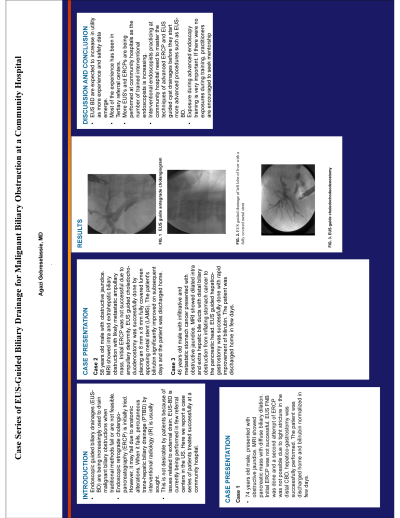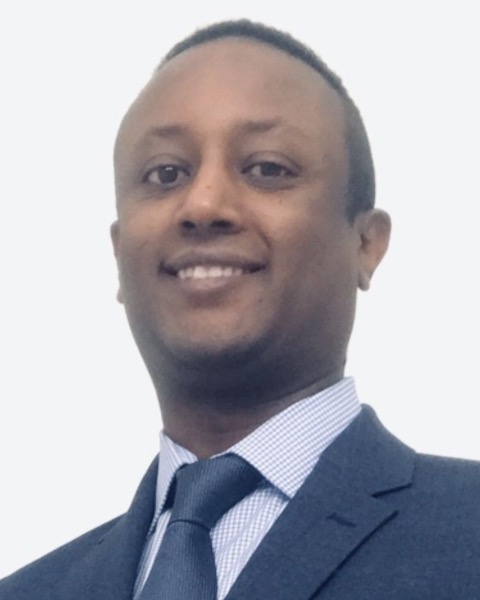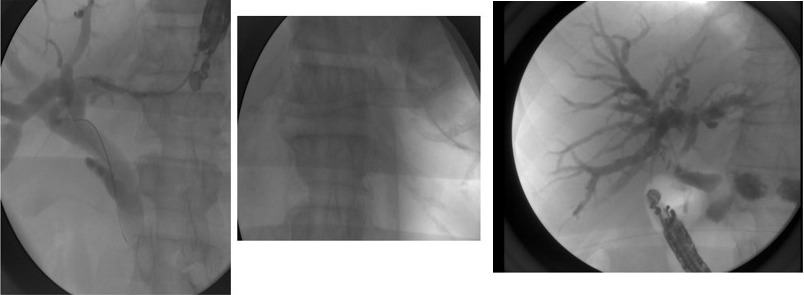Monday Poster Session
Category: Interventional Endoscopy
P2814 - Case Series of EUS-Guided Biliary Drainage for Malignant Biliary Obstruction at a Community Hospital
Monday, October 28, 2024
10:30 AM - 4:00 PM ET
Location: Exhibit Hall E

Has Audio

Agazi Gebreselassie, MD
University of Maryland Medical systems, BWMC, Woodholme GI
Clarksville, MD
Presenting Author(s)
Agazi Gebreselassie, MD
University of Maryland Medical systems, BWMC, Woodholme GI, Clarksville, MD
Introduction: Endoscopic guided biliary drainages (EUS-BD) are being increasingly used to drain malignant biliary obstructions when traditional methods fail or are not feasible. Endoscopic retrograde cholangio-pancreatography (ERCP) is initially tried. However, it may fail due to anatomic alterations. When it fails, percutaneous trans-hepatic biliary drainage (PTBD) by interventional radiology (IR) is usually sought. This is not desirable by patients because of issues related to external drain. EUS-BD is currently being performed in few referral centers in the US. Here we report a case series of patients treated successfully at a community hospital.
Case Description/Methods: Case 1
74 years old male, presented with obstructive jaundice. MRI showed pancreatic mass with diffuse biliary dilation. Initial ERCP was not successful. EUS FNB was done and a second attempt of ERCP was not possible due to tight stricture in the distal CBD. hepatico-gastrostomy was successfully performed. The patient was discharged home and bilirubin normalized in few days.
Case 2
58 years old male with obstructive jaundice. MRI showed intra and extrahepatic biliary obstruction with likely metastatic ampullary mass. Initial ERCP was not successful due to ampullary deformity. EUS guided choledocho-duodenostomy was successfully done by placing an 8 mm x 8 mm fully covered lumen apposing metal stent (LAMS). The patient's bilirubin significantly improved on subsequent days and the patient was discharged home.
Case 3
46 years old male with infiltrative and metastatic stomach cancer presented with obstructive jaundice. MRI showed dilated intra and extra hepatic bile ducts with distal biliary obstruction from inflating stomach cancer to the pancreatic head. EUS guided hepatico-gastrostomy was successfully done with rapid improvement of bilirubin. The patient was discharged home in few days.
Discussion: EUS BD are expected to increase in utility as more experience and safety data emerge. Most of the experience has been in Tertiary referral centers. More EUS's and ERCPs are being performed at community hospitals as the number of trained interventional endoscopists is increasing. Interventional endoscopists practicing at community hospital need to master the techniques of advanced ERCP and EUS guided cyst drainages before they start more advanced procedures such as EUS-BD. Exposure during advanced endoscopy training is very important. If there were no exposures during training, practitioners are encouraged to seek mentorship.

Disclosures:
Agazi Gebreselassie, MD. P2814 - Case Series of EUS-Guided Biliary Drainage for Malignant Biliary Obstruction at a Community Hospital, ACG 2024 Annual Scientific Meeting Abstracts. Philadelphia, PA: American College of Gastroenterology.
University of Maryland Medical systems, BWMC, Woodholme GI, Clarksville, MD
Introduction: Endoscopic guided biliary drainages (EUS-BD) are being increasingly used to drain malignant biliary obstructions when traditional methods fail or are not feasible. Endoscopic retrograde cholangio-pancreatography (ERCP) is initially tried. However, it may fail due to anatomic alterations. When it fails, percutaneous trans-hepatic biliary drainage (PTBD) by interventional radiology (IR) is usually sought. This is not desirable by patients because of issues related to external drain. EUS-BD is currently being performed in few referral centers in the US. Here we report a case series of patients treated successfully at a community hospital.
Case Description/Methods: Case 1
74 years old male, presented with obstructive jaundice. MRI showed pancreatic mass with diffuse biliary dilation. Initial ERCP was not successful. EUS FNB was done and a second attempt of ERCP was not possible due to tight stricture in the distal CBD. hepatico-gastrostomy was successfully performed. The patient was discharged home and bilirubin normalized in few days.
Case 2
58 years old male with obstructive jaundice. MRI showed intra and extrahepatic biliary obstruction with likely metastatic ampullary mass. Initial ERCP was not successful due to ampullary deformity. EUS guided choledocho-duodenostomy was successfully done by placing an 8 mm x 8 mm fully covered lumen apposing metal stent (LAMS). The patient's bilirubin significantly improved on subsequent days and the patient was discharged home.
Case 3
46 years old male with infiltrative and metastatic stomach cancer presented with obstructive jaundice. MRI showed dilated intra and extra hepatic bile ducts with distal biliary obstruction from inflating stomach cancer to the pancreatic head. EUS guided hepatico-gastrostomy was successfully done with rapid improvement of bilirubin. The patient was discharged home in few days.
Discussion: EUS BD are expected to increase in utility as more experience and safety data emerge. Most of the experience has been in Tertiary referral centers. More EUS's and ERCPs are being performed at community hospitals as the number of trained interventional endoscopists is increasing. Interventional endoscopists practicing at community hospital need to master the techniques of advanced ERCP and EUS guided cyst drainages before they start more advanced procedures such as EUS-BD. Exposure during advanced endoscopy training is very important. If there were no exposures during training, practitioners are encouraged to seek mentorship.

Figure: EUS BD hepaticogastrostomy and choledochoduodenostomy
Disclosures:
Agazi Gebreselassie indicated no relevant financial relationships.
Agazi Gebreselassie, MD. P2814 - Case Series of EUS-Guided Biliary Drainage for Malignant Biliary Obstruction at a Community Hospital, ACG 2024 Annual Scientific Meeting Abstracts. Philadelphia, PA: American College of Gastroenterology.
